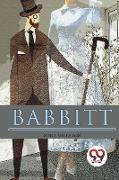Sinclair Lewis' satirical book Babbitt, published in 1922, is about American culture and society and criticizes the superficiality of middle-class life and the temptation to fit in. Babbitt's disagreement had a big impact on the decision to give Lewis the Nobel Prize in Literature in 1930. The book has been adapted into two motion pictures: a silent version in 1924 and a talkie version in 1934. Babbitt's life is chronicled in the first seven chapters over the course of a single day. Babbitt coos over his ten-year-old daughter Tinka during breakfast, tries to talk his 22-year-old daughter Verona out of her recent socialist tendencies and exhorts his 17-year-old son Ted to work more in school. He dictates letters while at work and has conversations with his staff on real estate advertising. Babbitt hurries home and abandons all disobedience when his wife develops acute appendicitis. They reestablish their intimacy during her prolonged recovery, and Babbitt returns to his emotionless conformity. In the climactic scene, Babbitt learns that his son Ted secretly wed Eunice, his neighbor's daughter. Though he doesn't agree, he declares that he is in favor of the union and commends Ted for leading an independent life.


